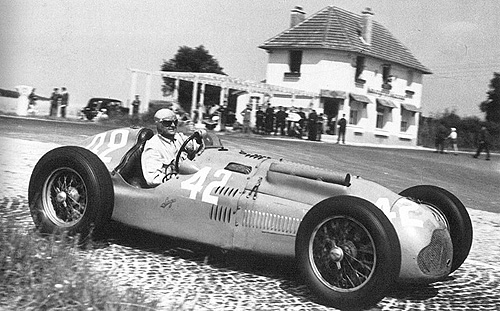

Editor: Jaap Horst

 It might be something of a stretch, but there is an argument for saying that Louis Chiron was talent-spotted by the French army, who assigned him to act as chauffeur to Marshals Foch and Petain during the First World War.
It might be something of a stretch, but there is an argument for saying that Louis Chiron was talent-spotted by the French army, who assigned him to act as chauffeur to Marshals Foch and Petain during the First World War.
Born in Monaco in August 1899, Louis Chiron enlisted with the French Army at the age of 18, in the final year of the Great War. Originally posted to the 85th Artillery Regiment, Chiron’s aptitude behind the wheel attracted the attention of the higher-ups in the armed forces, and they assigned him to drive for two of the highest-ranking officials in the French Army.
The skills honed on the battlefield would serve him well throughout his Grand Prix career, as Chiron went on to build a reputation as one of the most tenacious drivers of his day.
After the First World War, Chiron returned to Monaco, where he worked a variety of jobs in the principality’s hotels. One of these jobs was as a hired escort for the dances at the Hotel de Paris. While there is no suggestion that this escorting was a relation to the modern occupation that bears the same name, history states that a number of wealthy ladies were happy to sponsor up and coming race drivers in exchange for their company at social events.
In 1923, Chiron began to compete in races in and around the principality. But his racing career really took off in 1926, the year in which he met both Rudolf Caracciola and future employer Alfred Hoffman, heir to the Hoffman-La Roche pharmaceutical fortune. Hoffman was impressed with Chiron’s prowess behind the wheel, and agreed to sponsor the young Monegasque in a privately-entered Bugatti, the first 2.3l supercharged Type 35B.
While 1926 and 1927 brought minor success to the Chiron-Hoffman partnership, it was in 1928 that the results began rolling in. Chiron arrived at the European Grand Prix – held at Monza – with five grand prix wins under his belt, and collected his sixth win of the year at the Autodromo, beating some of the top names in pre-war racing. You can see highlights of the race in the clip below.
The rest of the decade brought more successes for Chiron and Hoffman, but their partnership came to an abrupt end in the early 1930s, around the time that Chiron became the first – and only – Monegasque to win the Monaco Grand Prix, a feat he achieved in 1931.
Chiron continued to race in grands prix without Hoffman’s financial support; for the 1932 season he had secured a works drive with the Bugatti team but was fired for an inability to take instruction. Unperturbed, Chiron formed Scuderia CC with Caracciola for the 1933 season. It was not to last – Caracciola was severely injured in practice for the Monaco Grand Prix, and Chiron was rudderless once more, until an offer came in to race with Scuderia Ferrari.
On 8 May, 1932, Chiron partnered with Achille Varzi in the Targa Florio, the legendary sportscar endurance race. The pair took a respectable third place; Tazio Nuvolari had commanded the race from the start, and held the lead around eight laps of the Little Madonie Circuit. Some footage of the event is in the clip below.
In 1934, Chiron continued to drive for Ferrari. It was a successful season, and probably the highlight of the later stages of his pre-war career. By 1935, German money was one of the most powerful factors in grand prix racing, and the Monegasque pilot’s funding came from other sources. But he continued to race until 1938, when he retired to Monaco. A year later, the Second World War broke out, and racing was put on hold until the late 1940s.
After the war, Chiron was tempted back behind the wheel. While the post-war period provided him with some success, notably his last single-seater race win at the 1949 French Grand Prix, Chiron’s heyday had passed. The only footage I’ve been able to find of Chiron in the post war period comes courtesy of the 1947 El Gezira Grand Prix, held on an island in the Nile.
Chiron’s racing career spanned a period of 35 years, and encompassed a win at the 1954 Monte Carlo Rally, multiple entries in the Le Mans 24 Hours endurance race, a class win at the 1956 Mille Miglia, and a win at the 1933 Spa 24 Hours endurance race. In 1958, a 58-year-old Chiron became the oldest man to compete in a Formula 1 World Championship race, his single-seater swansong.
But Chiron was far from a faultless human being. His personal history is littered with rumours of dubious love affairs and broken marriages, and he is believed to have lost his drive in Alfred Hoffman’s privately-entered Bugatti because he couldn’t keep his hands off the owner’s wife. (Perhaps more importantly, it is said that she couldn’t keep her hands off him…)
Probably the lowest point in Chiron’s history comes with his denunciation of Hellé Nice as a Gestapo spy. Although his claim was never substantiated, it destroyed Nice’s reputation. She had been a highly thought of Grand Prix driver, and possibly the most successful European female racer in the pre-war era. But following Chiron’s accusation – which has since been denied by the German government, and no biographer has been able to find any information supporting it – she was ostracized, and died alone and in poverty.
This article was first published on www.girlracer.co.uk